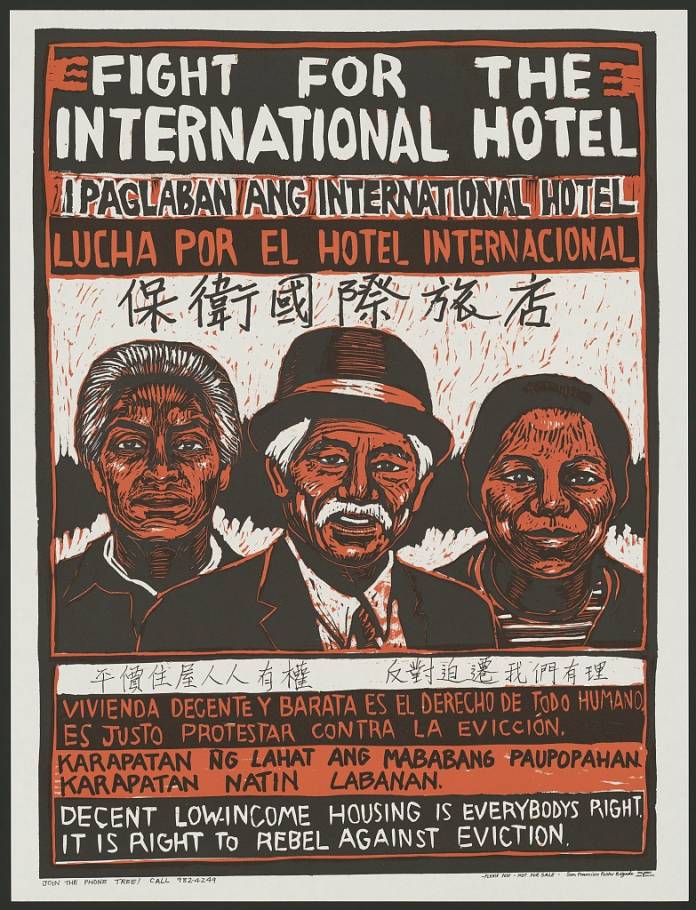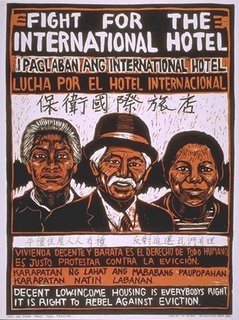
On August 4, 1977, a piece of San Francisco’s heart was torn out. At midnight, the San Francisco Sheriff’s Office broke down the door of the International Hotel, the heart of San Francisco’s Filipino Community, and physically evicted 55 mostly elderly, low-income residents.
It was a dramatic moment in San Francisco political history. Five Thousand protesters surrounded the building. Sheriff Richard Hongisto at first refused to carry out the eviction order, and spent five days behind bars in his own jail before relenting – and leading the eviction, breaking down the door himself with a sledgehammer.

Mayor Dianne Feinstein sided with the Thailand-based real-estate investor who was parking his money in the I-Hotel. Her appointees on the Planning Commission and the Board of Appeals voted in favor of the demolition, despite the fact that the owner of the property (who was trying to park his money in the US) had no plans to replace the building.
For more than 20 years, it sat there as a whole in the ground and a symbol of the failure of the city’s housing policy. Finally, in 2003, community-based organizations got the property back and rebuilt the hotel as low-income housing.
On Friday/4, the Manilatown Heritage Foundation will hold a commemoration at the new I-Hotel, featuring the amazing documentary film “The Fall of the I Hotel,” with a presentation by filmmaker Curtis Choy.
Here’s the schedule of events:
Opening Remarks: Tony Robles, Manilatown Heritage Foundation Board of Directors president
Unveiling of Chewang chi Biyeg Tapestry: Kalinga Master Weaver Jenny Bawer Young and Kalingafornia Laga
Original Defenders Panel
Moderated by Emil Guillermo, Journalist
Guest Panelists:
Emil DeGuzman , I-Hotel Tenants Association President
Estella Habal, Author “San Francisco’s International Hotel: Mobilizing the Filipino American Community in the Anti-Eviction Movement”
Pam Tau-Lee , Co-Founder Chinese Progressive Association
Juanita Tamayo-Lott , Community Activist
Screening of “The Fall of the I-Hotel” with Director Curtis Choy
Current Housing Rights Activists Panel
Moderated by Joy Ng , Veterans Equity Center
Guest Panelists: Angelica Cabande, Organizational Director of South of Market Community Action Network
Theresa Imperial, Veterans Equity Center Housing Case Manager
Tony Robles, Senior & Disability Action Housing Organizer
Candlelight Vigil led by Emil DeGuzman
6pm to 9pm, 868 Kearny St.


Available for viewing on Vimeo at
https://vimeo.com/album/3652524
(from the early, primitive, days of portable video…but apparently quite successful in encouraging similar program around the US)
Felix is a friend still today. I don't recall the video. For the project in Berkeley I took a Swedish King's Cabinet member to look at the mural projects. His idea was to put artists to work decorating underground passageways in Stockholm. Sweden as well as other European nations also had a spike in unemployment during the stagflation years.
I recall a City janitor job opened. Just to get the application a line formed around the block at City Hall and a riot broke out when some tried to cut in. They broke down front door at City Hall. That scene was playing out all over the nation. That was the last time Democrats and Republicans, Congress, Governors, and Mayors were all on the same page. Bureaucrats had nowhere to hide. I recall several heart attacks of local program administrators in our region who were under pressure to perform. Of course Eunice Elton took it all in stride.
Hey Don, do you remember the video by Optic Nerve titled "ArtWorks" ?
Some of your colleagues were probably featured: Elsa Cameron, Felix Contrereas, John Kriedler…..
I was the CETA Fed Rep for SF and Berkeley.
Redress does not excuse what happened.
In 1975 I was involved with making a documentary for the NEA about the cIty's innovative use of Comprehensive Employment and Training Act (CETA) funds to hire artists. We spent several days shooting in and around the I Hotel, speaking with tenants, artists, and activists; documenting poetry and oral history programs. I will never forget it. Whatever positive can be said for the eventual use of the property, the eviction of the tenants and the demolition of the hotel was a crime that will forever haunt the corner of Jackson and Kearny.
As I recall at the time the Fil-Am community was replacing Italians in the Excelsior and many could be found in Crocker-Amazon, Vis Vally etc. But seem to be dispersing to many other parts of the City. Then there there was the joke about the first three words spoken by a Filipino child in Daly City: Mama, Poppa, Serra Monte.
Oh tim, some weak history here.
Of course George Moscone was Mayor when the tenants were evicted in 1977. After efforts by his Housing Authority (then chaired by Jim Jones) to acquire the building via eminent domain failed in court. Feinstein was Mayor at the time of the demolition in 1980, but also set up an IH Advisory Committee to come up with a plan for the site's future, and her Planning Department held up approving any other development plans for the site for years. which actually did result in the negotiated purchase of the property by the Catholic Archdiocese in 1988 while she was still Mayor. give her that credit.
the final outcome – the development of the property with new senior housing including the small Manilatown Heritage Center storefront, a new Chinatown SF Community College campus, and a new St. Mary's School building is an outstanding example of positive community building by all concerned. the entire site wound up dedicated to forward-looking community purposes.
the Hotel's evicted tenants were able to move to other residential hotels in SOMA, mostly Sixth Street, which already was a larger Fil-Am neighborhood. rents there were still cheap in those days. a small number were even able to move into the new senior housing that opened in Yerba Buena Redevelopment Area in 1978-79 (but they did not have any priority rights for it due to the eviction).
the real tragedy was the forced extinction of that small Manilatown community. but that generation of pre-WWII Filipino agricultural workers that called the I-Hotel home – the Manongs – has all passed on. even if the Hotel had been saved as a renovated nonprofit SRO, today it would be just one more Chinatown community residence. which is not bad, but its small Fil-Am retail shops/kitchens would also have long since passed on too.
The real question today is what will happen to today's Central City Fil-Am community in SOMA. Gentrification is assaulting it on all sides. Just naming a park after Victoria Manalo Draves or new affordable housing after its departed community leaders – Rich Sorro, Bill Sorro, and others – when only a few of those new apartments are actually rented to Filipino-American tenants is nothing more than cynical historic tokenism. That's not real community building.
– john elberling